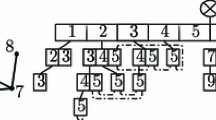Abstract
Many special classes of simplicial sets, such as the nerves of categories or groupoids, the 2-Segal sets of Dyckerhoff and Kapranov, and the (discrete) decomposition spaces of Gálvez, Kock, and Tonks, are characterized by the property of sending certain commuting squares in the simplex category \(\Delta \) to pullback squares of sets. We introduce weaker analogues of these properties called completeness conditions, which require squares in \(\Delta \) to be sent to weak pullbacks of sets, defined similarly to pullback squares but without the uniqueness property of induced maps. We show that some of these completeness conditions provide a simplicial set with lifts against certain subsets of simplices first introduced in the theory of database design. We also provide reduced criteria for checking these properties using factorization results for pushouts squares in \(\Delta \), which we characterize completely, along with several other classes of squares in \(\Delta \). Examples of simplicial sets with completeness conditions include quasicategories, many of the compositories and gleaves of Flori and Fritz, and bar constructions for algebras of certain classes of monads. The latter is our motivating example.
Similar content being viewed by others
Notes
It is worth noting that the theory of \((\infty ,1)\)-categories, which is modeled by quasicategories, also has closely related algebraic models [17].
See for example [19, Section 14.2].
Although the diagram still commutes when \(i = j - 1\), it is then no longer a pushout, as the single nontrivial \(\vee \)-component of its span is one of the following:

It is known that Graham reduction can be performed in any order, i.e. it is impossible to get stuck.
Note that the assumption of connectedness guarantees that the set-theoretic intersection \(T_k \cap \bigcup _{i=1}^{k-1}\) is nonempty.
A category is gaunt if the only isomorphisms are the identities.
See property 5 of Theorem 13.2 in there.
References
Beeri, C., Fagin, R., Meier, D., Yannakakis, M.: On the desirability of acyclic database schemes. J. Assoc. Comput. Mach. 30(3), 479–513 (1983)
Constantin, C., Fritz, T., Perrone, P., Shapiro, B.: Partial evaluations and the compositional structure of the bar construction (2020). arXiv:2009.07302
Dyckerhoff, T., Kapranov, M.: Higher Segal Spaces, volume 2244 of Lecture Notes in Mathematics. Springer, Cham (2019). arXiv:1212.3563
Feller, M., Garner, R., Kock, Joachim, P., May U., Weber, M.: Every 2-Segal space is unital. Commun. Contemp. Math. 23(2), 2050055 (2021). arXiv:1905.09580
Flori, C., Fritz, T.: Compositories and gleaves. Theory Appl. Categ. 31(33), 928–988 (2016). arXiv:1308.6548
Fritz, T.: A synthetic approach to Markov kernels, conditional independence and theorems on sufficient statistics. Adv. Math. 370, 107239 (2020). arXiv:1908.07021
Fritz, T., Perrone, P.: Monads, partial evaluations, and rewriting. In: Proceedings of MFPS 36, ENTCS (2020). arXiv:1810.06037
Gale, D.: Neighborly and cyclic polytopes. Proc. Sympos. Pure Math. 7, 225–232 (1963)
Gálvez-Carrillo, I., Kock, J., Tonks, A.: Decomposition spaces, incidence algebras and Möbius inversion I: basic theory. Adv. Math. 331, 952–1015 (2018). https://doi.org/10.1016/j.aim.2018.03.016
Gálvez-Carrillo, I., Kock, J., Tonks, A.: Decomposition spaces, incidence algebras and Möbius inversion II: completeness, length filtration, and finiteness. Adv. Math. 333, 1242–1292 (2018). https://doi.org/10.1016/j.aim.2018.03.017
Graham, M.H.: On the Universal Relation. Technical Report, University of Toronto, Toronto (1979)
Joyal, A.: Foncteurs analytiques et espèces de structures. In Labelle, Gilbert, Leroux, Pierre. editors, Combinatoire énumérative, volume 1234 of Lecture Notes in Math., pages 126–159. Springer Berlin Heidelberg (1986)
Joyal, A.: Quasi-categories and Kan complexes. J. Pure Appl. Algebra 175(1–3), 207–222 (2002). (Special volume celebrating the 70th birthday of Professor Max Kelly)
Joyal, A., Tierney, M.: Notes on simplicial homotopy theory (2008). http://mat.uab.cat/~kock/crm/hocat/advanced-course/Quadern47.pdf
Lurie, J.: Higher Topos Theory. Annals of Mathematics Studies, Princeton University Press, Princeton (2009). arXiv:math/0608040
Maier, D.: The Theory of Relational Databases. Computer Software Engineering Series, Computer Science Press, Rockville (1983)
Nikolaus, T.: Algebraic models for higher categories. Indag. Math. (N.S.) 21(1–2), 52–75 (2011). arXiv:1003.1342
Poguntke, T.: Higher Segal structures in algebraic \(K\)-theory (2017). arXiv:1709.06510
Riehl, E.: Categorical Homotopy Theory. Cambridge University Press, Cambridge (2013)
Walde, T.: Higher Segal spaces via higher excision (2019). arXiv:1906.10619
Wegner, G.: \(d\)-collapsing and nerves of families of convex sets. Arch. Math. (Basel) 26, 317–321 (1975)
West, D.B.: Introduction to Graph Theory. Prentice Hall Inc, Upper Saddle River (1996)
Acknowledgements
We first of all thank Joachim Kock for detailed comments on an earlier version, which have resulted in various improvements to the exposition. This paper originates from the Applied Category Theory 2019 school. We thank the organizers Daniel Cicala and Jules Hedges for having made it happen, the Computer Science Department of the University of Oxford for hosting the event, as well as all other participants of the school for the interesting discussions and insights, especially Martin Lundfall.
Funding
Research at Perimeter Institute is supported in part by the Government of Canada through the Department of Innovation, Science and Economic Development Canada and by the Province of Ontario through the Ministry of Colleges and Universities. Research for the third author was partly funded by the Fields Institute (Canada), and by the AFOSR Grants FA9550-19-1-0113 and FA9550-17-1-0058 (USA). The fourth author was supported by the National Defense Science and Engineering Graduate Fellowship Program.
Author information
Authors and Affiliations
Corresponding author
Additional information
Communicated by George Janelidze.
Publisher's Note
Springer Nature remains neutral with regard to jurisdictional claims in published maps and institutional affiliations.
Rights and permissions
Springer Nature or its licensor (e.g. a society or other partner) holds exclusive rights to this article under a publishing agreement with the author(s) or other rightsholder(s); author self-archiving of the accepted manuscript version of this article is solely governed by the terms of such publishing agreement and applicable law.
About this article
Cite this article
Constantin, C., Fritz, T., Perrone, P. et al. Weak cartesian properties of simplicial sets. J. Homotopy Relat. Struct. 18, 477–520 (2023). https://doi.org/10.1007/s40062-023-00334-1
Received:
Accepted:
Published:
Issue Date:
DOI: https://doi.org/10.1007/s40062-023-00334-1




